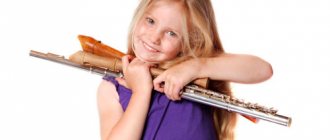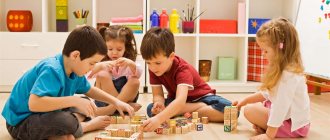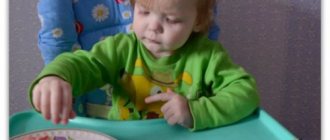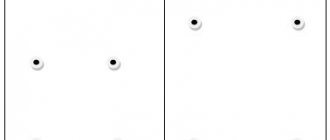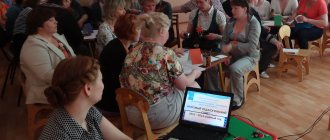Features of child development at 2 years old
At this age, the baby enjoys exploring the world around him, he wants to touch everything, taste it, and see what is inside. He already has good control over his body and can do some things on his own.
Physical development:
- the child learned to coordinate movements;
- large and fine motor skills are sufficiently developed;
- the movements are correct.
Self-care skills:
- eats and drinks himself;
- goes to the toilet and washes himself, washes his hands;
- can take off and put on clothes without assistance.
Intellectual development:
- vocabulary is actively replenished;
- enjoys communicating with other children and adults;
- feels a high need to study the world around him;
- drawing, dancing, music, singing.
What to do with your child for physical development
The simplest and most effective activity you can offer your child is all kinds of ball games. You can start by simply throwing a ball into the child’s hands, especially since this game is also suitable for a small apartment. During the lesson, grasping movements and the ability to quickly and accurately calculate each action are developed.
Another version of the game: sit on the floor opposite each other, spread your legs wide so that it looks like a goal. By rolling the ball back and forth along a certain trajectory, the child will learn to concentrate on his actions.
Another interesting ball game, of course, is edible-inedible. It is not only funny and liked by all kids without exception, but also perfectly develops reaction, because you need to quickly figure out whether the named item can be eaten or not, and make the right decision.
What else can you do with the ball?
- play football with alternating legs;
- throw it up;
- try to throw into the basket;
Overcoming all sorts of obstacles is also useful for physical development: for example, practicing on the wall bars, balance beam, and horizontal bar. Young children do not have a strong sense of danger, so they should exercise on sports equipment only under the supervision of their parents.
Basic principles of teaching a 2 year old child
Parents do not always have the opportunity to send their child to kindergarten from the age of two. In such cases, it is recommended to organize training and creative activities at home yourself. It is important to note that all exercises must be performed in a playful manner. It is strictly forbidden to force children to do something without desire. This can completely discourage you from learning in the future.
Classes from 2 years old
Classes for children aged 2-3 years are very easy to organize on your own. For this purpose, there are a huge number of educational games and didactic materials that allow you to diversify your activities. Any activity should be bright, interesting, and deliver only positive emotions. Children immediately lose interest as soon as they realize that they are forcing them.
Games for intellectual development
This group includes games aimed at improving fine motor skills and sensory perception. The way a child moves his fingers and arms is interconnected with the development of important brain centers, such as the centers of speech, vision, motor coordination, and thinking. What educational activities can you organize at home?
- Coloring large pictures and drawing with paints, crayons, pencils.
- Cutting out basic shapes from cardboard with scissors.
- Modeling from salt dough, plasticine, clay. Start with koloboks and sausages and gradually move on to more complex figures.
- Various applications made from paper, magazine pictures, cardboard.
- Games with small objects: beans, colored rice (color regular cereal with food coloring for eggs), buttons, shells, mini cars.
Let your child take apart a regular dresser drawer, just make sure all the items are safe first. Another simple game is to put beans or buttons into a plastic bottle with a narrow neck.
Don't ask your child to create a masterpiece right away. Always go from the simplest to the most complex and don’t put pressure on the child if he doesn’t succeed or is tired. Be sure to explain safety rules. Help him in the first lessons, over time he will learn to perform these actions on his own. Don't be stingy with praise, even if the house you painted doesn't look like a building. Set up a home exhibition and show your creations to other family members so that your child remembers the state of success.
Lesson plan for a 2 year old child at home for a week
Mothers with small children never have free time. In order to conduct classes correctly, taking into account all the necessary aspects of development, it is recommended to draw up a detailed plan for the week. The outline will help you clearly see whether all aspects of educational activity are covered. Activities may vary depending on the time of year. For example, in the summer it is best to spend more time walking, where you can also come up with educational games for children.
A sample lesson plan might look like this:
- Monday: exercises, reading rhymes, repeating what you read, modeling from plasticine.
- Tuesday: dancing and playing with musical instruments, for example, a procession with drums; leaf applique; game with cereals.
- Wednesday: exercise outside in case of good weather; painting with finger paints, building a house for a bear cub and a garage for his car.
- Thursday: musical morning warm-up, theatrical performance of the kolobok fairy tale; making a dough ball.
- Friday: exercises with reading rhymes, playing with water (pouring liquid from one vessel to another, reading a fairy tale and a short retelling.
- Saturday: trip to the zoo, on the way back ask clarifying questions about who the child saw at the zoo, please describe the animals. Drawing animals from the zoo.
- Sunday: exercises, didactic game of halves “who is whose baby”, modeling from plasticine.
On a note! It is very important that parents pay as much attention as possible to activities with the baby and communication. Playing alone alone will lead to the baby growing up withdrawn. This will lead to adaptation problems in the future.
Why do you need to play in the sandbox?
The sandbox is not only a place where a child makes his first friends. For children, it is a powerful source of tactile sensations and creative opportunities that promote intellectual development.
- The construction of castles, tunnels and other structures awakens imagination.
- Baking Easter cakes and playing with molds help to better distinguish shapes and sizes.
- Interaction with other children develops communication skills and outlook.
- Fine grains of sand provide constant massage to the fingers and palms, which has a beneficial effect on the development of speech and sensory centers.
Books and manuals for baby development
At 2 years old, the child already knows basic animals, some plants, seasons, and the names of a number of objects. The purpose of any auxiliary material is to continue the development that has begun and expand the child’s horizons.
Books for a 2-year-old child are divided into several types:
- fairy tales;
- poems;
- stories about nature;
- educational books.
The latter are worth talking about in more detail. Today, the shelves of bookstores surprise with a variety of educational toys for the little ones. We present to your attention a list of the most popular of them.
- “Smart books” from the author Olga Zemtsova delight parents at an affordable price. The series is aimed at developing horizons, intellectual and creative abilities. The age of children is from 1 to 6 years. In addition to thin magazines, the series includes massive books.
- “Preschool Mosaic” is the second widely known creation of Olga Zemtsova. The advantage is the bright design and the presence of stickers with tasks. Age for training is from 2 to 6 years.
- “School of the Seven Dwarfs” is the most popular publication for the development of children, created by recognized teachers and psychologists. Age – from birth to school entry. The annual course consists of 12 brochures with didactic games for the comprehensive development of a child in accordance with age.
- “New Child - Genius from the Diaper” by the author Elena Yanushko is a reusable album for creativity.
“I myself!”
Allow your child to touch as many objects as possible, study their shape, size, surface quality, color, purpose. It is important for a child to accumulate as much knowledge as possible about the world around him and learn to apply it correctly. Involve your son or daughter in feasible household chores:
- sweep the floor - you can buy a small broom and dustpan;
- wash the dishes after yourself - it’s good if they are made of plastic;
- dress and undress, put clothes and toys in place;
- wash;
- wipe the table with a napkin, etc.
This will make him more independent, help him learn important self-care skills, and give you some free time.
Development of speech skills
The vocabulary of children aged 2-3 years is already quite diverse. Two-year-old children are able to ask the question: “What is this?” when pointing at an object with a finger. They understand the speech of an adult addressed to them. They work well with previously learned words in combination with new ones.
In general, throughout the preschool period, the baby’s vocabulary grows. For example, by the end of the second year of life, a child’s speech contains about 200 words, and after half a year - 400. Upon reaching the age of three, the number of words approaches 1000. The grammatical form gradually becomes correct and understandable, but sometimes errors can occur.
How to develop speech?
Be sure to tell your child fairy tales and learn simple nursery rhymes and songs together. Children's works, as a rule, have a short, memorable plot, and you can easily perform a mini-play based on them. For example, while reading the same “Teddy Bear,” you can repeat the movements of the furry hero yourself or with the help of your favorite toy.
Be sure to pronounce words clearly, because the child learns to pronounce them based on the sound sample you provide. If he pronounces a word incorrectly, immediately give the correct example.
Communicate with your child. Ask him how he is doing, what interesting things he saw on the street, which paw hurts his favorite bunny, etc. In this regard, role-playing games are very useful, since in them the child learns to correctly use phrases and clichés heard in a similar situation.
Educational games - as an element of raising a child under two years old
A two-year-old child does not yet understand what is good and what is bad, and the main responsibility of every parent is to explain this to him.
The simplest games with an educational element that you can play with a child from one to two years old:
- Girls love to play with dolls from a very young age. Help your daughter dress the doll, feed it and bathe it. Important: it is best to buy a large rag doll, without small parts.
- You can instill a love of order in boys by playing “parking.” After the game, all cars must drive into the parking lot, the role of which can be played by a table or a cardboard box.
- When doing exercises with your child, encourage the correctness of the exercises. Important: the exercises should be very simple, for example: “sway in the wind”, or “grow and become a tree”.
After playing, always collect your child's toys in a specially designated place and ask your child to help you.
Sand games
Games in the sandbox develop imagination.
Activities for your child in the sandbox are very useful:
- building castles develops imagination;
- the production of “pies” from sand teaches you to distinguish the shape of the product;
- sand massages the fingertips and palms, improving blood circulation and brain activity of the baby;
- Playing with other children broadens your horizons and develops sociability.
Drawing on glass sprinkled with sand promotes the development of imagination and independence.
A two-year-old child and the peculiarities of his thinking
The child is growing and becoming more active and smart every month. Don't miss this chance and direct all your energy in the right direction. You may notice that the growing little person has become capricious and wants to assert his own “I”. He often uses hand pushes and foot stomping - all part of child psychology. Learn to patiently explain what can and cannot be done. Treat your baby as an adult and when communicating, try to squat down so that your eyes are at the level of his face.
A 2-year-old child learns by imitating. Therefore, if you want to raise an inquisitive person who strives for knowledge, do not sit all day in front of the TV and do not chat with your friends on the phone all evening. Your idleness will become a bad example for your child. It’s better to sit your son or daughter next to you at the table, give him a pencil and a piece of paper for drawing, and solve a crossword puzzle or read a book. You can draw with your baby.
At this age, a child wants to do everything himself. Don't discourage independence from the very beginning! If your baby wants to put on tights or button up a sweater on his own, wait patiently while he fiddles with buttons or an unruly pant leg. Help only when the child asks. Regardless of whether the child did it or not, praise him.
Hand coordination and motor skills
Touch is important to children. You probably noticed that at 1.5 years old the child carefully watched his hands. Now you need to learn how to control your limbs. Activities with a 2-year-old child should include playing with fingers. Learn rhymes that will turn the activity into an interesting story. Let the baby bend and straighten the corresponding fingers, learn the game “Foods”. With the help of such exercises, hand coordination develops. Touch your child's hands as often as possible. Such physical contact with parents is very important for every child.
Why is it so important to develop fine motor skills? Because when the fingers work, nerve impulses provoke the development of those parts of the brain that are responsible for the speech apparatus. This means that fine motor skills are responsible for the development of a child’s speech. In addition, this is good preparation for future penmanship classes.
How to organize classes correctly
For proper speech development, children aged 2-3 years can be given special “speech tasks”. They can be simple or complex. Simple: Repeat a specific sound. Difficult: “Go to dad and ask him to give you a typewriter.” Such tasks make the child need to ask questions “where?”, “where?”, “which?”.
Set up a puppet theater at home. Details for it can be purchased at the store or made yourself. First, the parents act as the puppeteer, and then they need to switch places.
I want to remember everything!
What is memory? This is the ability to reflect on past experiences. From birth, the baby perfectly develops reflexes that are based on memory. At first the baby does not react at all to his parents, but then he begins to smile at his mother, who is associated with food. He simply remembered that this particular woman was capable of giving milk. This is a primitive example, which is based on the child’s first memory experience.
At 2-3 years old, involuntary memory appears: the baby remembers some words and simple poems. Naturally, in order to remember them, you need to speak and show them repeatedly. This is why children need developmental activities. 2 years is a very important age. Use toys and picture cards, remember that lessons should not last more than 30 minutes.
Let's look at a few simple games that will help develop memory skills.
- Place any three toys in front of your baby. Talk about each of them. Next, ask the child to turn away and remove one character behind his back. Let the child name who is missing in this three. Over time, increase the number of participants - the more items, the more difficult it is to remember them.
- Show your child the picture, then turn it over and ask him to describe the action drawn. To make it easier, you can ask leading questions, for example, “what color dress is the girl wearing?”, “What grows near the tree?” Ask to bring items from another room.
- Get into the habit of socializing before bed. For example, read a fairy tale, and tomorrow afternoon let the child tell the story he heard. Ask them to tell you what interesting things happened to the little family member all day. Sing songs and recite rhymes. All this contributes to the development of the memory of your beloved child.


